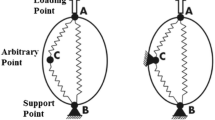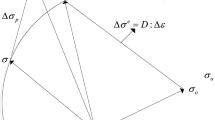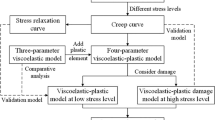Abstract
The ductility of structure or component is particularly important when it encounters earthquake or other sudden disasters. It can reduce the damage of structure to a certain extent. The ductility mechanism of structure is closely related to the analysis of elastic–plastic behavior of structure. Therefore, an improved transfer matrix method based on elastic–plastic transfer element is proposed to analyze the elastic–plastic behavior of structures. The elastic–plastic element consists of two parts, elastic region and plastic region. According to the section stress analysis, the ratio of elastic zone to plastic zone can be determined to reflect the elastic–plastic behavior. The analysis process is as follows: firstly, the elastic–plastic part of the structure is determined according to the mechanical behavior of the whole structure, then the elastic–plastic transfer unit is proposed according to the determined proportion of the elastic–plastic zone, and finally the mechanical behavior of the whole structure is analyzed. Through numerical examples, the correctness and effectiveness of the proposed method are verified by comparing the analytical model with the theoretical solution. The results show that this method provides a new way for the further study of engineering structure mutation process.























Similar content being viewed by others
References
Antoni, N. (2019). A novel rapid method of purely elastic solution correction to estimate multiaxial elastic-plastic behaviour. Journal of Computational Design and Engineering, 6(3), 269–283.
Arai, M., Kuroda, S., & Ito, K. (2021). Static Elastic-Plastic Analysis of a Pipe Structure by the Transfer Matrix Method. Journal of Pressure Vessel Technology-Transactions of the ASME, Doi, 10(1115/1), 4047680.
Baggett, J. F., & Martin, J. B. (1983). Evaluation of the inelastic spectrum design method for two degree-of-freedom structures under earthquake loading. Engineering Structures, 5(4), 247–254.
Canh, V. L., Tran, T. D., & Pham, D. C. (2016). Rotating plasticity and nonshakedown collapse modes for elastic–plastic bodies under cyclic loads. International Journal of Mechanical Sciences, 111–112, 55–64.
Chopra, A. K., & Chintanapakdee, C. (2004). Inelastic deformation ratios for design and evaluation of structures: Single-degree-of-freedom bilinear systems. Journal of Structural Engineering, 130(9), 1309–1319.
Dastjerdi, S., & Abbasi, M. (2019). A Vibration Analysis of a CrackedMicro-cantilever in an Atomic Force Microscope by Using TransferMatrix Method. Ultramicroscopy, 196, 33–39.
Dokainish, M. A. (1972). A New Approach for Plate Vibrations: Combination of Transfer Matrix and Finite-Element Technique. Journal of Engineering for Industry, 94(2), 526–530.
Duan, L., & Reno, M. (1999). Performance-Based Seismic Design Criteria For Bridges. CRC Press LLC.
Firstov, S. A., Podrezov, Y. N., Shtyka, L. G., Zherdin, A. G., & Malyshenko, A. A. (1990). Modeling of the ductile-brittle transition in porous metallic materials under conditions of crack resistance tests. Powder Metallurgy and Metal Ceramics, 29(5), 411–416.
Geradin, M., & Chen, S. L. (1995). An exact model reduction technique for beam structures: Combination of transfer and dynamic stiffness matrices. Journal of Sound and Vibration, 185(3), 431–440.
Guarracino, F. (2019). Remarks on the stability analysis of some thin-walled structures in the elastic-plastic range. Thin-Walled Structures, 138, 208–214.
Shokrollahi, H., Fallah, F., Naghdabadi, R., & Kargarnovin, M. H. (2017). Elastic-plastic behavior of sandwich cylindrical shell panels with a flexible core. Proceedings of the Institution of Mechanical Engineers, 231(2), 223–241.
Hong, H. P., & Hong, P. (2007). Assessment of ductility demand and reliability of bilinear single-degree-of-freedom systems under earthquake loading. Canadian Journal of CivilEngineering, 34(12), 1606–1615.
Huang, Q., Choe, J., Yang, J., et al. (2019). An efficient approach for post-buckling analysis of sandwich structures with elastic-plastic material behavior. International Journal of Engineering Science, 142, 20–35.
Jiang, Y., Ott, W., & Baum, C. (2009). Fatigue life predictions by integrating EVICD fatigue damage model and an advanced cyclic plasticity theory. International Journal of Plasticity, 25(5), 780–801.
Jiang, H., Lu, X., & Zhu, J. (2012). Performance-based seismic analysis and design of code-exceeding tall buildings in Mainland China. Structural Engineering and Mechanics, 43(4), 1–16.
Karavasilis, T. L., & Seo, C. Y. (2011). N Makris Dimensional Response Analysis of Bilinear Systems Subjected to Non-Pulse-like Earthquake Ground Motions. Journal of Structural Engineering, 137(5), 600–606.
Li, R., & Sieradzki, K. (1992). Ductile-brittle transition in random porous Au. Physical Review Letters, 68(8), 1168–1171.
Lignos, D. G., & Krawinkler, H. D. (2011). eterioration modeling of steel components in support of collapse prediction of steel moment frames under earthquake loading. Journal of Structural Enginee, 137(11), 1291–1302.
Lin, Y., Zhang, X., Xu, W., & Zhou, M. (2019). Importance Assessment of Structural Members Based on Elastic-Plastic Strain Energy. Advances in Materials Science and Engineering., 2019, 1–17.
Liu, Y., Zhang, X,, & Cen, Z. (2003). Lower bound limit analysis of three dimensional elastoplastic structures by boundary element method. Applied Mathematics and Mechanics, 24(12), 1301–1308.
Mahbod, M., Asgari, M., & Mittelstedt, C. (2020). Architected functionally graded porous lattice structures for optimized elastic-plastic behavior. Proceedings of the Institution of Mechanical Engineers Part l-Journal of Materials-Design and Applications, 234(8), 1099–1116.
Mavroeidis, G. P., & Dong, G. (2004). AS Papageorgiou Near-fault ground motions and the response of elastic and inelastic single-degree-of-freedom (SDOF) systems. Earthquake Engineering Structural Dynamics, 33(9), 1023–1049.
McClintock, F. A. (1968). A Criterion for Ductile Fracture by the Growth of Holes. Journal of Applied Mechanics, 35(2), 363–371.
Miranda, E. (1993). Evaluation of Site-Dependent Inelastic Seismic Design Spectra. ASCE Journal of Structure Engineering, 199(5), 1319–1338.
Nassar, A, A., &Krawinkler, H. (1991). Seismic for SDOF and MDOF System, Report No.95, The John A . Blume Earthquake Engineering Center, Stanford University, Stanford, California.
Newmark, N. M., & Hall, W. J. (1982). Earthquake spectra and design. Berkeley, California: EERI.
Park, R., & Paulay, T. (1975). Reinforced concrete structures. John Wiley & Sons.
Petruska, J., Kubik, P., Hulka, J., & Sebek, F. (2013). Ductile fracture criteria in prediction of chevron cracks. Advanced Materials Research, 716, 653–658.
Pineau, A. (2008). Modeling ductile to brittle fracture transition in steels-micromechanical and physical challenges. International Journal of Fracture, 150(1), 129–156.
Riddell, R. (1995). Inelastic Design Spectra Accounting for Soil Conditions. Earthquake Engineering & Structural Dynamics, 24(11), 1491–1510.
Rodigari, D., Franchi, A., & Genna, F. (2019). A linear complementarity approach to the time integration of dynamic elastic-plastic structural problems. Meccanica, 54(10), 1597–1609.
Su, X., Kang, H., et al. (2020). Modeling and parametric analysis of in-plane free vibration of a floating cable-stayed bridge with transfer Matrix Method. International Journal of Structural Stability and Dynamics, 20(1), 2050004.
Su, X., Kang, H., & Guo, T. (2019). Dynamic analysis of the in-plane free vibration of a multi-cable-stayed beam with transfer matrix method. Archive of Applied Mechanics, 89(12), 2431–2448.
Sun, J., Huang, W., Zhu, L., Liu, Y., & Yang, J. (2020). Investigation and finite element simulation analysis on collapse accident of Heyuan Dongjiang Bridge. Engineering Failure Analysis, 115, 104655.
Wallach, J. C., & Gibson, L. J. (2001). Mechanical behaviorof a three-dimensional truss material. International Journal of Solids and Structures, 38(40–41), 7181–7196.
Wang, R., Tsai, K.-C., & Lin, B. (2011). Extremely large displacement dynamic analysis of elastic-plastic plane frames. Earthquake Engineering and Structural Dynamics, 40, 1515–1533.
Wu, J. Y., & Xu, S. L. (2011). An augmented multicrack elastoplastic damage model for tensile cracking. Int. Solids Struct, 48, 2511–2527.
Yao, D., Cai, L., & Chen, B. (2016). A new fracture criterion for ductile materials based on a finite element aided testing method. Materials Science & Engineering, 673, 633–647.
Yi, W. J., Zhang, H. Y., & Kunnath, S. K. (2007). Probabilistic Constant-Strength Ductility Demand Spectra. Journal of Structural Engineering, 133(4), 567–575.
Yu, J., & Tan, K. H. (2017). Structural behavior of reinforced concrete frames subjected to progressive collapsed. ACI Structural Journal, 114(1), 63–74.
Zhai, C., & Xie, L. (2005). Constant-ductility strength demand spectra for seismic design of structures. Earthquake Engineering and Engineering Vibration, 4(2), 243–250.
Zhan, L., Wang, S., Xi, H., & Xiao, H. (2020). High and low cycle fatigue failure effects of metals predicted automatically from innovative elastoplastic equations with high-efficiency algorithms. Continuum Mechanics and Thermodynamics., 33(4), 1041–1052.
Acknowledgements
The financial support of Xi’an Science and technology innovation talent service enterprise project (2020KJRC0047), Provincial Natural Science Foundation of Shaanxi (2020JM-475) and National Natural Science Foundation of China (Grant Nos. 51408453) are much appreciated.
Author information
Authors and Affiliations
Corresponding author
Additional information
Publisher's Note
Springer Nature remains neutral with regard to jurisdictional claims in published maps and institutional affiliations.
Rights and permissions
About this article
Cite this article
Sun, J., Liu, K., Liu, G. et al. A Developed Transfer Matrix Method for Analysis of Elastic–Plastic Behavior of Structures. Int J Steel Struct 21, 1620–1629 (2021). https://doi.org/10.1007/s13296-021-00524-8
Received:
Accepted:
Published:
Issue Date:
DOI: https://doi.org/10.1007/s13296-021-00524-8




